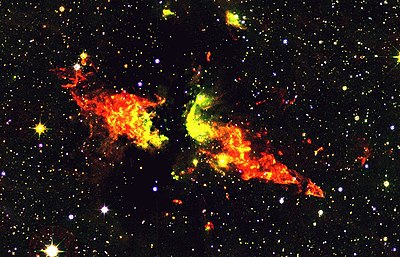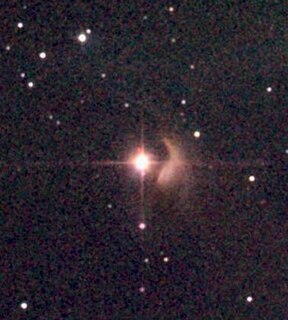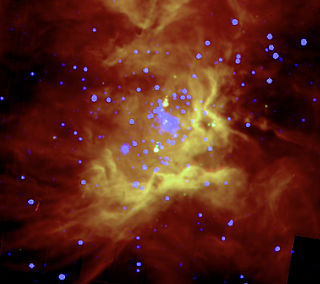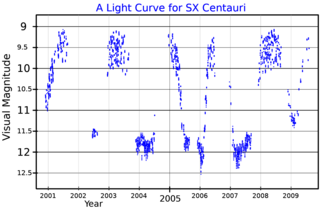
A bipolar outflow comprises two continuous flows of gas from the poles of a star. Bipolar outflows may be associated with protostars (young, forming stars), or with evolved post-AGB stars (often in the form of bipolar nebulae).

A bipolar outflow comprises two continuous flows of gas from the poles of a star. Bipolar outflows may be associated with protostars (young, forming stars), or with evolved post-AGB stars (often in the form of bipolar nebulae).
In the case of a young star, the bipolar outflow is driven by a dense, collimated jet. These astrophysical jets are narrower than the outflow and very difficult to observe directly. However, supersonic shock fronts along the jet heat the gas in and around the jet to thousands of degrees. These pockets of hot gas radiate at infrared wavelengths and thus can be detected with telescopes like the United Kingdom Infrared Telescope (UKIRT). They often appear as discrete knots or arcs along the beam of the jet. They are usually called molecular bow shocks, since the knots are usually curved like the bow wave at the front of a ship.
Typically, molecular bow shocks are observed in ro-vibrational emission from hot molecular hydrogen. These objects are known as molecular hydrogen emission-line objects, or MHOs.
Bipolar outflows are usually observed in emission from warm carbon monoxide molecules with millimeter-wave telescopes like the James Clerk Maxwell Telescope, though other trace molecules can be used. Bipolar outflows are often found in dense, dark clouds. They tend to be associated with the very youngest stars (ages less than 10,000 years) and are closely related to the molecular bow shocks. Indeed, the bow shocks are thought to sweep up or "entrain" dense gas from the surrounding cloud to form the bipolar outflow.
Jets from more evolved young stars - T Tauri stars - produce similar bow shocks, though these are visible at optical wavelengths and are called Herbig–Haro objects (HH objects). T Tauri stars are usually found in less dense environments. The absence of surrounding gas and dust means that HH objects are less effective at entraining molecular gas. Consequently, they are less likely to be associated with visible bipolar outflows.
The presence of a bipolar outflow shows that the central star is still accumulating material from the surrounding cloud via an accretion disk. The outflow relieves the build-up of angular momentum as material spirals down onto the central star through the accretion disk. The magnetised material in these protoplanetary jets is rotating and comes from a wide area in the protostellar disk. [1]
Bipolar outflows are also ejected from evolved stars, such as proto-planetary nebulae, planetary nebulae, and post-AGB stars. Direct imaging of proto-planetary nebulae and planetary nebulae has shown the presence of outflows ejected by these systems. [2] [3] Large spectroscopic radial velocity monitoring campaigns have revealed the presence of high-velocity outflows or jets from post-AGB stars. [4] [5] [6] The origin of these jets is the presence of a binary companion, where mass-transfer and accretion onto one of the stars lead to the creation of an accretion disk, from which matter is ejected. The presence of a magnetic field causes the eventual ejection and collimation of the matter, forming a bipolar outflow or jet.
In both cases, bipolar outflows consist largely of molecular gas. They can travel at tens or possibly even hundreds of kilometers per second, and in the case of young stars extend over a parsec in length.
Massive galactic molecular outflows may have the physical conditions such as high gas densities to form stars. This star-formation mode could contribute to the morphological evolution of galaxies. [7]


A planetary nebula is a type of emission nebula consisting of an expanding, glowing shell of ionized gas ejected from red giant stars late in their lives.

The Cat's Eye Nebula is a planetary nebula in the northern constellation of Draco, discovered by William Herschel on February 15, 1786. It was the first planetary nebula whose spectrum was investigated by the English amateur astronomer William Huggins, demonstrating that planetary nebulae were gaseous and not stellar in nature. Structurally, the object has had high-resolution images by the Hubble Space Telescope revealing knots, jets, bubbles and complex arcs, being illuminated by the central hot planetary nebula nucleus (PNN). It is a well-studied object that has been observed from radio to X-ray wavelengths.

T Tauri is a variable star in the constellation Taurus, the prototype of the T Tauri stars. It was discovered in October 1852 by John Russell Hind. T Tauri appears from Earth amongst the Hyades cluster, not far from ε Tauri, but it is actually 420 light-years behind it and was not formed with the rest of them. The cloud to the west of the system is NGC 1555, known more commonly as Hind's Variable Nebula.

Minkowski 2-9, abbreviated M2-9 is a planetary nebula that was discovered by Rudolph Minkowski in 1947. It is located about 2,100 light-years away from Earth in the direction of the constellation Ophiuchus. This bipolar nebula takes the peculiar form of twin lobes of material that emanate from a central star. Astronomers have dubbed this object as the Twin Jet Nebula because of the jets believed to cause the shape of the lobes. Its form also resembles the wings of a butterfly. The nebula was imaged by the Hubble Space Telescope in the 1990s.

The Egg Nebula is a bipolar protoplanetary nebula approximately 3,000 light-years away from Earth. Its peculiar properties were first described in 1975 using data from the 11 µm survey obtained with sounding rocket by Air Force Geophysical Laboratory (AFGL) in 1971 to 1974.

Herbig–Haro (HH) objects are bright patches of nebulosity associated with newborn stars. They are formed when narrow jets of partially ionised gas ejected by stars collide with nearby clouds of gas and dust at several hundred kilometres per second. Herbig–Haro objects are commonly found in star-forming regions, and several are often seen around a single star, aligned with its rotational axis. Most of them lie within about one parsec of the source, although some have been observed several parsecs away. HH objects are transient phenomena that last around a few tens of thousands of years. They can change visibly over timescales of a few years as they move rapidly away from their parent star into the gas clouds of interstellar space. Hubble Space Telescope observations have revealed the complex evolution of HH objects over the period of a few years, as parts of the nebula fade while others brighten as they collide with the clumpy material of the interstellar medium.

An astrophysical jet is an astronomical phenomenon where outflows of ionised matter are emitted as an extended beam along the axis of rotation. When this greatly accelerated matter in the beam approaches the speed of light, astrophysical jets become relativistic jets as they show effects from special relativity.

In astronomy, Bok globules are isolated and relatively small dark nebulae, containing dense cosmic dust and gas from which star formation may take place. Bok globules are found within H II regions, and typically have a mass of about 2 to 50 solar masses contained within a region about a light year or so across (about 4.5×1047 m3). They contain molecular hydrogen (H2), carbon oxides and helium, and around 1% (by mass) silicate dust. Bok globules most commonly result in the formation of double- or multiple-star systems.

A protoplanetary nebula or preplanetary nebula is an astronomical object which is at the short-lived episode during a star's rapid evolution between the late asymptotic giant branch (LAGB) phase and the subsequent planetary nebula (PN) phase. A PPN emits strongly in infrared radiation, and is a kind of reflection nebula. It is the second-from-the-last high-luminosity evolution phase in the life cycle of intermediate-mass stars.

The Red Rectangle Nebula, so called because of its red color and unique rectangular shape, is a protoplanetary nebula in the Monoceros constellation. Also known as HD 44179, the nebula was discovered in 1973 during a rocket flight associated with the AFCRL Infrared Sky Survey called Hi Star. The binary system at the center of the nebula was first discovered by Robert Grant Aitken in 1915.

HH 46/47 is a complex of Herbig–Haro objects, located around 450 parsecs away in a Bok globule near the Gum nebula. Jets of partially ionized gas emerging from a young star produce visible shocks upon impact with the ambient medium. Discovered in 1977, it is one of the most studied HH objects and the first jet to be associated with young stars was found in HH 46/47. Four emission nebula, HH 46, HH 47A, HH 47C and HH 47D and a jet, HH 47B, have been identified in the complex. It also contains a mostly unipolar molecular outflow, and two large bow shocks on opposite sides of the source star. The overall size of the complex is about 3 parsecs.

HH 34 is a Herbig–Haro object located in the Orion A molecular cloud at a distance of about 460 parsecs. It is notable for its highly collimated jet and very symmetric bow shocks. A bipolar jet from the young star is ramming into surrounding medium at supersonic speeds, heating the material to the point of ionization and emission at visual wavelengths. The source star is a class I protostar with a total luminosity of 45 L☉. Two bow shocks separated by 0.44 parsecs make the primary HH 34 system. Several larger and fainter bow shocks were later discovered on either side, making the extent of the system around 3 parsecs. The jet blows up the dusty envelope of the star, giving rise to 0.3 parsec long molecular outflow.
Scott Jay Kenyon is an American astrophysicist. His work has included advances in symbiotic and other types of interacting binary stars, the formation and evolution of stars, and the formation of planetary systems.

HL Tauri is a very young T Tauri star in the constellation Taurus, approximately 450 light-years (140 pc) from Earth in the Taurus Molecular Cloud. The luminosity and effective temperature of HL Tauri imply that its age is less than 100,000 years. At apparent magnitude 15.1, it is too faint to be seen with the unaided eye. It is surrounded by a protoplanetary disk marked by dark bands visible in submillimeter radiation that may indicate a number of planets in the process of formation. It is accompanied by the Herbig–Haro object HH 150, a jet of gas emitted along the rotational axis of the disk that is colliding with nearby interstellar dust and gas.

RCW 36 is an emission nebula containing an open cluster in the constellation Vela. This H II region is part of a larger-scale star-forming complex known as the Vela Molecular Ridge (VMR), a collection of molecular clouds in the Milky Way that contain multiple sites of ongoing star-formation activity. The VMR is made up of several distinct clouds, and RCW 36 is embedded in the VMR Cloud C.

IRAS 08544−4431 is a binary system surrounded by a dusty ring in the constellation of Vela. The system contains an RV Tauri variable star and a more massive but much less luminous companion.

SX Centauri is a variable star in the constellation Centaurus. An RV Tauri variable, its light curve alternates between deep and shallow minima, varying its apparent magnitude from 9.1 to 12.4. From the period-luminosity relationship, it is estimated to be around 1.6 kpc from Earth. Gaia Data Release 2 gives a parallax of 0.2175 mas, corresponding to distance of about 4,600 pc.

HD 101584 is a suspected post-common envelope binary about 1800 to 5900 light-years distant in the constellation of Centaurus. The system is bright at optical wavelengths with an apparent visual magnitude of about 7. The primary is either a post-AGB star, but more likely a post-RGB star. The secondary is a red dwarf or possibly a low-luminosity white dwarf, which orbits the primary every 150-200 days. The system is surrounded by a slowly rotating circumbinary disk, probably with a face-on orientation towards the solar system and a size of about 150 astronomical units.

KjPn 8 is a bipolar planetary nebula which was discovered by M.A. Kazaryan and Eh. S. Parsamyan in 1971 and independently by Luboš Kohoutek in 1972.

RW Aurigae is a young binary system in the constellation of Auriga about 530 light years away, belonging to the Taurus-Auriga association of the Taurus Molecular Cloud. RW Aurigae B was discovered in 1944.
| Wikimedia Commons has media related to Herbig-Haro objects . |